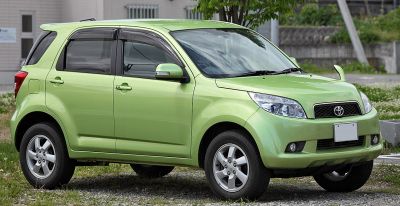 1998 Mitsubishi Pajero IO (H60) Dimensions, Size & Specs
1998 Mitsubishi Pajero IO (H60) Dimensions, Size & SpecsMeasurements of the 1998 Mitsubishi Pajero IO, engineered for optimal performance and comfort
| Dimensions | |
|---|---|
| Length: | 3975 mm156.5 in13.0 ft |
| Width: | 1680 mm66.1 in5.5 ft |
| Height: | 1710 mm67.3 in5.6 ft |
| Weight Specifications | |
| Curb Weight: | 1390 kg3064 lbs |
| Maximal permitted Weight: | 1665 kg3671 lbs |
| Tire Specifications | |
| Tire Size: |
|
The Mitsubishi Pajero IO (H60), produced from 1998 to 2005, is a compact SUV designed to offer a perfect balance between urban driving agility and off-road capability. Measuring 3975 mm (156.5 inches) in length, 1680 mm (66.1 inches) in width, and 1710 mm (67.3 inches) in height, the Pajero IO fits comfortably in tight city environments while maintaining a commanding SUV stance. With a curb weight of 1390 kg (3064 lbs) and a maximum gross weight of 1665 kg (3671 lbs), it is lightweight enough to remain fuel-efficient without compromising sturdiness or performance. The vehicle rides on 215/65 R16 S tires, striking a balance between ride comfort and traction on varied terrain. These specifications make the Pajero IO (H60) an attractive option for drivers looking for a reliable compact SUV from the late 1990s and early 2000s. Its moderate size ensures easy maneuverability in crowded streets, while the substantial height provides good ground clearance for off-road adventures. The Pajero IO is a practical choice for SUV enthusiasts seeking a versatile vehicle that combines Mitsubishi's hallmark durability with compact convenience.
Discover the standout features that make the 1998 Mitsubishi Pajero IO a leader in its class
Have a question? Please check our knowledgebase first.
The Mitsubishi Pajero IO (H60), produced from 1998 to 2005, has a compact yet practical size for an SUV of its era. It measures 3975 mm (156.5 inches) in length, making it suitable for urban and moderate off-road use. The width stands at 1680 mm (66.1 inches), providing a stable stance without being overly wide for tight city streets or parking spaces. Its height is 1710 mm (67.3 inches), offering comfortable headroom inside and a commanding driving position. These dimensions combine to make the Pajero IO a balanced SUV that is easy to handle while still offering off-road capabilities.
The Pajero IO (H60) has a curb weight of approximately 1390 kg (3064 lbs), which is relatively lightweight for an SUV. This weight positively influences its agility and handling, making it less cumbersome in urban environments or on winding roads. Additionally, the lighter weight helps improve fuel efficiency compared to heavier SUVs, which means the vehicle can deliver decent mileage without sacrificing the durability and robustness expected from the Pajero lineage. The maximum gross weight, including passengers and cargo, is 1665 kg (3671 lbs), ensuring the vehicle can handle a respectable payload while maintaining stability.
The Pajero IO's moderate dimensions make it well suited for fitting into a standard residential garage. With a width of 1680 mm (66.1 inches) and height of 1710 mm (67.3 inches), it easily fits within the typical garage width of around 2400-2700 mm (94.5-106 inches) and height of about 2100-2400 mm (82.7-94.5 inches). The length of 3975 mm (156.5 inches) also usually matches the space provided in standard garages, which are typically around 4800-5500 mm (189-216 inches) deep. Therefore, owners can confidently park the Pajero IO inside conventional home garages without much concern for space limitations.
With a width of 1680 mm (66.1 inches), the Pajero IO falls right within the compact SUV category prevalent in the late 1990s and early 2000s. Many competitors like the Suzuki Jimny or Daihatsu Terios offered similar widths, allowing the Pajero IO to navigate urban traffic and off-road trails with ease. Its relatively narrow stance compared to larger SUVs also benefits maneuverability, parking, and fuel economy without compromising interior space significantly. This width strikes an effective balance between stable road behavior and urban practicality.
The Pajero IO is equipped with 215/65 R16 S tires, which means the tires are 215 mm wide with an aspect ratio of 65% sidewall height relative to the width, fitted on 16-inch wheels. The 'S' rating indicates a speed rating suitable for everyday driving conditions. These tires provide a comfortable ride with good grip on both paved roads and light off-road terrain. The 16-inch diameter helps absorb road irregularities, contributing to a smoother ride quality and enhanced vehicle stability during cornering or rough conditions.
The Pajero IO stands 1710 mm (67.3 inches) tall, which is relatively tall for a compact SUV, providing excellent headroom for most passengers and giving the driver a commanding view of the road. This height contributes to an upright seating position that enhances visibility and driver confidence, especially in off-road or urban environments. The elevated roofline also allows better accommodation of taller passengers and improves overall cabin spaciousness, making it comfortable during longer drives or when carrying passengers.
The Mitsubishi Pajero IO replaced the earlier Mitsubishi Pajero Junior, which was slightly smaller in overall dimensions. The Pajero IO expanded in length and height to offer better interior space and more versatile utility. While the Pajero Junior was designed more as a compact SUV for city use, the Pajero IO introduced improved off-road capabilities with a more robust frame yet maintained a manageable footprint for everyday driving. These dimensional enhancements made the Pajero IO more practical and comfortable, serving a broader range of drivers looking for a compact but capable SUV.
When compared to similar compact SUVs such as the Suzuki Jimny or Daihatsu Terios, the Mitsubishi Pajero IO generally offers dimensions that are competitive but slightly larger, particularly in length and height. For instance, the Jimny tends to be shorter and narrower, emphasizing off-road agility, while the Pajero IO balances that with a bit more interior room and comfort. The Terios is closer in size but the Pajero IO often stands out for providing a slightly more robust, rugged design with practical dimensions that cater to both urban use and light off-roading, striking a versatile middle ground.
The Mitsubishi Pajero IO (H60) has a maximum weight capacity (gross vehicle weight rating) of 1665 kg (3671 lbs). This capacity includes the vehicle's curb weight of 1390 kg (3064 lbs) plus passengers, cargo, and any additional equipment. This means the Pajero IO can safely carry around 275 kg (607 lbs) of additional load, which translates to roughly three average adult passengers plus some luggage or gear. This capacity ensures that the vehicle maintains safe handling and performance characteristics even when fully loaded for trips or outdoor adventures.
The Mitsubishi Pajero IO was typically offered with small-displacement, efficient four-cylinder engines aimed at balancing performance with fuel economy. Exact engine options varied by market but generally included 1.8L petrol engines and sometimes diesel variants, producing moderate power suitable for city driving and moderate off-road use. The focus was on providing reasonable fuel consumption while retaining the capacity and robustness expected from an SUV. Fuel efficiency for the Pajero IO was competitive for its time, offering a practical choice for drivers needing a versatile, economical vehicle.
Discover similar sized cars.

| Production: | 1997-2003 |
|---|---|
| Model Year: | 1997 |
| Length: | 3980 mm156.7 in |
| Width: | 1695 mm66.7 in |
| Height: | 1675 mm65.9 in |

| Production: | 2006-2008 |
|---|---|
| Model Year: | 2006 |
| Length: | 3995 mm157.3 in |
| Width: | 1695 mm66.7 in |
| Height: | 1705 mm67.1 in |
